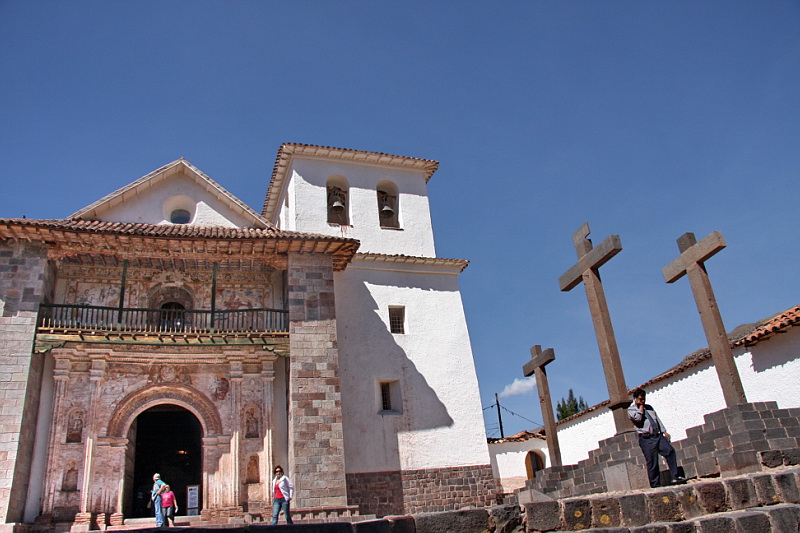Andahuaylillas
The district of Andahuaylillas is part of the province of Quispicanchis and it is located at 3198m.a.s.l. (3100 meters) (10170 feet), 35 km (about 25 miles, 1 hour ) to the south (east) of Cusco by the paved road leading to Puno. Andahuaylillas is a small town with not a severe climate as it is surrounded by mountains in the left bed of the Vilcanota river which is named as Urubamba in the lowest regions. Its lands are fertile and its people are quiet and friendly. Anciently, the name of this city was Antawaylla (Anta=cooper, Waylla=field). Both voices joint means "coppery field". Its old name was Antawaylla translated as "coppery field". Then the name was "Andahuaylas" but it was the same to a bigger province in Apurimac. For this reason, they changed it to Andahuaylillas using the short way.The "Sistine Chapel" of America

The most important attraction for the visitors is its church: San Pedro de Andahuaylillas considered ad the "Sistine Chapel" of America due to the quality of its art pieces.
Built at the beginning of VII century, the interior of the temple is decorated with murals performed by Luis Riaсo ( XVII century) representing the path to glory and the path to hell. He was also said to be the author of the low borders of the wall and an important oil painting of the archangel San Miguel. Besides, this church holds a majestic piano, numerous canvases of the Academy of Cusco, silver work and baroque altars.
Despite of having quite modest architecture, the decoration of its inner parts is the most impressive of this religious site as it holds a never seen before collection of the Academy of Cusco. It represents the life of San Pedro with marvelous golden frames. Besides, there is also a painting of the "Virgen de la Asuncion" made by the Spanish painter Esteban Murillo.
The surface behind the facade has many murals which are said to have been done by Luis de Reaсo ( XVII century). They represent the election the man takes to go by the path to hell or the path of glory leading to heaven.
Inside the church there are some remains of Inca buildings and a grate of architecture of transition (from Inca to Colonial architecture). In the occidental side of the grate, in its lintel, there are two sculptures of quadrupeds. Those were the Jesuits who built the church at the end of XVI century with the mud-brick sun-dry and wide walls, very similar to colonial buildings. Its quite simply architectonical structure is the typical style of churches in small towns. They simply have an upper bell tower, a faзade decorated with murals, and two stone columns perfectly designed to face the main grate.
Inside the church there are two different sections as they were built in two different stages. The main inner arch separates them. The older section has ornaments in Arabic style (the architects call it Arabic mixture, Christians developed it between XIII and XVI centuries). The new section is near the entrance. For this reason, the church has two pulpits, the older one is under the interior arch and the new one is in the opposite wall.
The quantity of murals covering the walls and mainly the ceiling with geometric models and decorated flowers with gold flakes is amazing. The high altar is baroque, carved in cedar wood and decorated with gold flakes. In the middle of this altar we find the statue of the "Virgen del Rosario" (Virgin of the Rosary). Its tabernacle is covered with silver plates. Going down, it also has an area of mirrors to reflex the light of the candles as well as the light entering through the grate in order to improve the inner illumination. On one side of the high altar we find the Sacristy that has old trunks where they kept the clothes of priests embroidered with precious metals. They also kept gold jewellery and silver jewellery that was stolen in 1992 and never found. There also some altars and lateral chapels, and in the upper part of the central area there is an interesting collection of anonymous canvases of the Academy of Cusco representing the life of San Peter with amazing golden frames. In the interior arch there is a painting of the "Virgen de la Asuncion" performed by the Spanish painter Esteban Murillo.
Entering the church through its main grate, to the left, we find the baptistery, and around its entrance it is written: "I baptise him in the name of the Father, and the Son, and the Holly Spirit, Amen". The most interesting fact is that the writings are in five languages: Latin, Spanish, Quechua, Pukina and Aymara (now Pukina is a dead language). On the surface behind the faзade, there are some murals representing the profane crowded and attractive road leading to hell, and another powerful road leading to heaven.
Going out, in the western side of the frontal patio of the church there are three big crosses that represent the Trinity: a symbol of the Saint Catholicism, that is, Father, Son and Holly Spirit.